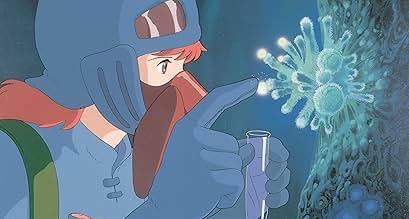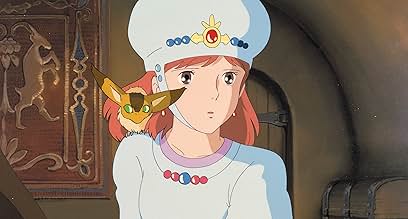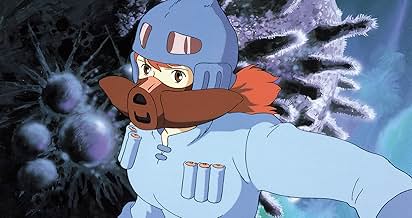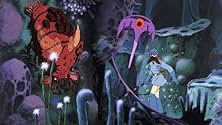Warrior and pacifist Princess Nausicaä desperately struggles to prevent two warring nations from destroying themselves and their dying planet.Warrior and pacifist Princess Nausicaä desperately struggles to prevent two warring nations from destroying themselves and their dying planet.Warrior and pacifist Princess Nausicaä desperately struggles to prevent two warring nations from destroying themselves and their dying planet.
- Awards
- 3 wins & 1 nomination total
- Nausicaä
- (voice)
- Jihl
- (voice)
- …
- Oh-Baba
- (voice)
- Mito
- (voice)
- Goru
- (voice)
- Gikkuri
- (voice)
- Niga
- (voice)
- Teto
- (voice)
- …
- Girl A
- (voice)
- Girl B
- (voice)
- Boy A
- (voice)
- Asbel
- (voice)
- Rastel
- (voice)
- Mayor of Pejite
- (voice)
- (as Makoto Terada)
- Rastel's Mother
- (voice)
- Kushana
- (voice)
Featured reviews
I tracked down a copy of the VHS and sent it to my young nieces, pleased with a "kid's" movie which provided a positive role model without being dumb. The movie captivated them as well -- they wore the tape out, and it started them on a lifelong interest in anime. It was they who sent me the uncut subtitled version years later, completing the circle.
Nausicaa is decent science fiction, often breath-taking animation, and unusually *human* characters, and every time I see it I am glad I returned. Everyone should give it a chance, especially those who have written off anime as "round eyed kids and lots of explosions".
I'm mentioning Minimata but the tragedy of Fukushima could have inspired a similar intuition that technological advances could only lead to the downfall of humanity inasmuch as men continue to display the same carelessness and arrogance. In his "Nausicaä", Hayao Miyazaki doesn't warn us but rather confronts us to a plausible future, a future with a few survivors driven to the last corners of Earth where wind and water prevented a toxic jungle name Fukaï from spreading.
The film, all in visual splendor, displays the usual Sci-fi and Fantasy archetypes but they don't distract from the environmentalist and pacifist message. We accept them in the sense that the story is set one thousand years after the apocalypse and we expect technology to have produced jet-propelled gliders and flying vessels. But the film also has a Renaissance look à la "Princess Mononoke", it's not an artistic license, the privileged people of the Valley represent a wiser side of humanity that got back to the roots, acknowledging the eminence of nature, a renaissance indeed.
They live in an oasis-like area where the air is breathable, outside; they must wear a gas mask, accentuating the dystopian look even within a natural setting. The hostility of nature is symbolized by giant mutant insects and the Ohm, armored trilobite-like insects whose eyes turn to an ominous red whenever they feel threatened. But Miyazaki never lets us get the wrong idea about these Ohm, understand they're not the most life-threatening creatures out there.
There's a key scene right in the beginning where a little fox-like creature bites Nausicaä, she patiently keeps her finger until its frenzy fades out and then the animal licks her wound. This moment is pivotal because it highlights the real tragedy that caused men's downfall, not violent actions but immediate assumptions of violence causing bad reactions. Only Nausicaä is capable of showing mercy and empathy toward any living creature, she challenges all the common conceptions and even tries to understand the place she lives in, which is the epitome of wisdom.
From the spores taken during regular expedition, she discovers in her laboratory that plants are capable of producing air, later in the film that some jungle plants purify the polluted topsoil and produce clean water. In other words, life always finds a way but humans can't see it. Nausicaä becomes the messianic character that will open the eyes of humanity, and as truth can be stranger than fiction, she's also a pivotal moment in Miyazaki's career, as the first film to have emerged from the fertile soil of his own imagination.
Nausicaä foreshadows all the elements that will define his work: the independent free-spirited heroine, the aerial settings and the environmental and anti-war messages, and more than that, the revolutionary notion that you don't need villains to make a story. Everyone is imperfect and fallible, even the most violent attacks are meant as defensive moves or precautions. The film contains a lot of action, lethal explosions and battles, people die by the sword, including Nausicaä's but Miyazaki couldn't have been more pacifists, every detail says in subtext that violence isn't the answer.
Indeed, how can the cause of the trouble ever be the solution? Miyazaki, a master storyteller, delivers crucial information even in the most unnoticeable moments, even the opening credits show through Roman mosaic and medieval tapestry the fate of the modern world. Seven giants launching immense fire blasts (metaphor for nuclear power?) into modern buildings, it's just as if Hiroshima was depicted like the Pompeii eruption. But what is the tragedy exactly, that history taught men a lesson or that men didn't learn it?
Nausicaä is set at a time that looks like a second chance but people are still fighting for good or bad reasons, from a sword master and father-figure named Lord Yupa, a young Pejite interceptor who respects Nausicaä's actions and the Tolmekian queen who (like Lady Eboshi from "Mononoke") is perhaps the tumultuous counterpart to Nausicaä, mutilated by the creatures, she believes in violence as the language of the force, illustrating its dangerously communicative effect, the never-ending spiral that killed the world or that might lead to a third worldwide conflict.
And in the midst of nihilistic violence and desolation, Nausicca emerges as a beautifully inspirational heroine. There's a hypnotic flashback (with a so-catchy playful tone) where Nausicaä's father kills a baby Ohm, on the basis that human and insects can't live together. The whole conviction of Nausicaä is that every creature has its place on Earth; it's not just about empathy but the unshakable faith on Nature's equilibrium. It is very significant that the most beautiful images from the film, all in golden yellow, are provided by the Ohm's tentacles, weren't they supposed to be the ugly monsters?
Yet, at the time of its release, the film was badly edited for foreign audiences and lost into translation to become some Manga adventure in the air, and the Ohm were indeed hostile creatures. It's just as if Miyazaki was ahead of his time and it would take one decade and half before people would come back to their senses and realize that this isn't "Flash Gordon". Nausicaä is about conviction and goodness, pacifism and environmentalism deprived from any political innuendo.
Miyazaki drew the original Manga so the film could be made, showcasing as much confidence as his heroine. In a way, Miyazaki was the Nausicaä of animation, a man with a vision, spirit and guts.
Although the incredible "Princess Mononoke" later upstaged this early work in terms of art and detail, in many ways I still prefer "Nausicaa". Its imaginitive and well-conceived world puts me in mind of Dune with its feuding factions, its giant creatures, and its strong ecological message. Even with a rather long running time, the story moves very briskly (boiled down as it was from a very lengthy manga series). The music deserves special mention, as well, as it is a large step up from the electronic pop stylings of most anime.
If you can get your hands on a copy of the original version, you'll find it more than worth the effort.
Without revealing too much of the plot, it takes us through the life of Nausicaa, a princess of a small village, and her struggles to stop warring nations from destroying an important source that can save the planet. The planet has already gone through a major destruction that nearly wiped out humanity, and their are large insects called ohmu, that guard the source that is spreading through the world.
Miyazaki introduces an empowerment of female characters in his animes, such as Princess Mononoke, Kiki's Delivery Service, and his most recent, Howl's Moving Castle (Hauru no ugoku shiro). The characters are done with style and care, and, in Nausicaa, there is no exception.
It amazes me that this film created some controversy when released, being banned in Poland because of it's depiction of an ecological disaster. Though the movie is obviously fantasy, it turns out that some may consider it a touchy subject. I didn't find any offense whatsoever with anything the movie showed, just a futuristic disaster no doubt caused by man.
Combining fantasy and science-fiction, Nausicaa is nice to look at. It certainly shows it's age when compared to some newer animes, not having the help from high-end computers. Considering it was done in the 80's, Miyazaki's production team did a great job. Little details, backgrounds, gadgets, & animals are drawn slightly better then some Japanese animes from that time.
Keep in mind that my review is based on the Disney release (Feb 2005). It's cleaned up, unedited, with new voices from well known actors that sound great (but I still prefer subtitles). Keep far away from the old version 'Warriors of the Wind', which chops off more then half-hour from the movie.
9 out of 10
Technically not a Ghibli film (Miyazaki actually used the studio which did most of 'The Last Unicorn', and which more or less became Ghibli when 'Laputa' was made a couple of years later), 'Nausicaa' is a far-future SF story with a princess/warrior/nature-lover heroine and strong environmental themes. There's also an opposing princess/leader trying to use technology to overcome the apparently hostile environment. If you're starting to think 'Princess Mononoke', you'd be on the right track. In some ways 'Nausicaa' seems like an early stab in the direction of 'Mononoke', though the latter would delve far more into spirituality and mythology, eschewing the SF aspects.
There aren't really any major weak points in Nausicaa - unless you count the frustrating 12 drawings per second animation which I constantly complain about in Japanese animation. The backgrounds aren't as amazing and the animation not as good as the last few Ghibli films, but for 1984 it was plenty good enough. I have a fairly trivial complaint in that the character of Kuratowa is drawn in a slightly more 'anime' style, ala Lupin III, whereas all of the other characters are done in a realistic style. He just seems a little out of place, though he's quite delightfully drawn.
The really strong points of the movie are its pacing (at least until the very end. Miyazaki was unhappy with the end too), its story telling, which manages to be sophisticated without being impossibly complex, its engrossing background drawings and settings, - and most of all in the amazing attention to detail in the fully realized post-apocalypse SF-fantasy world in which the story is set. Every little thing is worked out and placed such that you find yourself admiring inventions, ideas, structures, creatures, etc which don't draw attention to themselves, but simply exist as part of the backdrop of the movie. Of course 'Nausicaa' had existed for several years as a serialised Manga, so Miyazaki no doubt knew its universe inside-out.
There's a very clever plot, which I won't give away, but which involves humanity's relationship with the Earth and nature.
It's the sort of movie which you can get thoroughly caught up in, and which will stand repeated viewings. It really is a film which is perfectly pitched at both a young and an adult audience. As Miyazaki's second feature film it is also, rightly or wrongly, usually considered the start of Studio Ghibli, and is arguably worth watching for historical reasons, too.
Not the very best from Miyazaki or Ghibli, but an auspicious beginning.
PS, in case you didn't know, there was a heavily butchered US version floating around called 'Warriors of the Wind', which is universally reviled as a disgrace. Just to make it confusing, some of the Japanese copies are also called 'Warriors of the Wind'. The thing to look for is the 116 minute running length. If you get that, you've got the right one. At the moment the only way you can get the film is in Japanese dialog with English subtitles. Personally I'd go ahead and do that, rather than wait while Disney squats on the US distribution rights (Amazon gives it a release date of 2010 for God's sake). You can always replace it later.
Good stuff.
Storyline
Did you know
- TriviaWhen Nausicaä was first released as an English dub in the U.S. in 1985 it was drastically cut down to 1 hour and 35 minutes and titled Warriors of the Wind. Writer and Director Hayao Miyazaki was still so upset by the truncated "Warriors of the Wind" version of Nausicaä that when Harvey Weinstein approached him to discuss the distribution to his following film Princess Mononoke (1997) and insisted on a similar heavily cut version of the movie, Miyazaki angrily left the meeting. Several days later, Studio Ghibli producer Toshio Suzuki sent a katana sword to Weinstein's office with "NO CUTS" embedded into its blade. The movie was later released in the U.S. in its uncut version. During a later interview, Miyazaki commented on the incident by smiling and stating, "I defeated him." Nausicaä was his only film to suffer heavy editing on first release. In 1995 the US rights returned to Miyazaki and he made a distribution deal with Disney. In 2003 a new English dub with Patrick Stewart and Uma Thurman was released in the uncut 117 minute (1hr 57min) version. - James LaPierre WUD Films
- GoofsDuring the climactic battle scene, the design of Oh-Baba's headband changes several times. It sometimes has gold beads instead of gold-circled turquoise beads on the end-pieces, and alternately terminates with a single or a double line of cord.
- Quotes
Nausicaä: Every one of us relies on water from the wells, because mankind has polluted all the lakes and rivers. but do you know why the well water is pure? It's because the trees of the wastelands purify it! And you plan to burn the trees down? You must not burn down the toxic jungle! You should have left the giant warrior beneath the earth!... Asbel, tell them how the jungle evolved and how the insects are gaurding it so we won't pollute the earth again. Asbel please!
- Crazy creditsAs the credits roll we see life returning to normal in the valley: Kushana, Kurotowa and the Tolmekian fleet leave peacefully, after Nausicaä has unheard words for Kushana. The denizens of the Valley of the Wind replant trees in the burned-down forest. Lord Yupa and Asbel ride Yupa's beasts to the Toxic Jungle and explore it. When the text "The End" appears on screen we see Nausicaa's discarded helmet in the forest, alongside a green, non-Toxic Jungle sapling.
- Alternate versionsIn the original Japanese version of the film, a World Wildlife logo praising the film is displayed at the beginning. For the US release from Disney, this logo was replaced with a typical Studio Ghibli logo.
- ConnectionsEdited into Tales of the Valley of the Wind (2009)
- SoundtracksKaze no Tani no Naushika (Symbolic Theme Song)
Lyrics by Takashi Matsumoto
Music by Haruomi Hosono
Arranged by Mitsuo Hagita
Vocals by Narumi Yasuda (Tokuma Japan)
Details
Box office
- Budget
- $1,000,000 (estimated)
- Gross US & Canada
- $495,770
- Gross worldwide
- $9,012,301
Contribute to this page


































